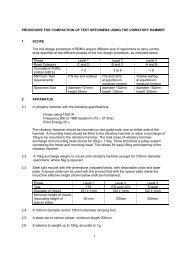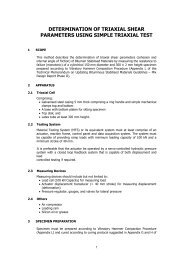Updating Bituminous Stabilized Materials Guidelines Mix Design Report Phase II
Moisture Sensitivity: Part II (Validation) - Asphalt Academy
Moisture Sensitivity: Part II (Validation) - Asphalt Academy
- No tags were found...
Create successful ePaper yourself
Turn your PDF publications into a flip-book with our unique Google optimized e-Paper software.
4. CONCLUSIONS AND RECOMMENDATIONS<br />
The investigation on wet trafficking and fundamental characteristics of BSMs associated with<br />
moisture damage studied through APT (MMLS3) device approach. Based on the data of the<br />
study, the following conclusions and recommendations are drawn:<br />
The approach employed in wet trafficking in this study successful accomplished the objectives<br />
to,<br />
- investigate test procedure, which is applicable for BSMs on moisture exposure using APT<br />
device (MMLS3).<br />
- validate the behaviour of selected BSMs on moisture susceptibility<br />
- Correlate the validated behaviour of BSMs on MMLS3 to the MIST device testing system.<br />
- Make appropriate recommendations regarding the use of the APT device on screening<br />
BSMs based on moisture related damage for mix design<br />
4.1 Load application<br />
- The used of APT Device (MMLS3) has shown potential in identification of BSMs distress<br />
under wet trafficking. It can therefore suitably be adapted for testing <strong>Bituminous</strong><br />
Stabilised <strong>Materials</strong> (BSMs).<br />
- The use of vinite or reinforced rubber mat proves to minimise the direct abrasion of<br />
wheel to the specimen. However, the vinite layer seen not be effective once severe<br />
cohesion loss of BSMs occurred.<br />
- The new variables applied on MMLS3 i.e. 420kPa tyre pressure, 1.8kN wheel load, and<br />
speed of 7200wheel per hour, seemed to provide acceptable level of screening the BSMs<br />
in term of moisture susceptibility.<br />
- The new variables applied on MMLS3 also found to validate the results obtained with<br />
MIST testing device.<br />
- The influence on curing of BSMs on wet performance is significant. Long term cured<br />
BSMs withstanding significant number of load application (100 000 wet axles) with small<br />
ravelling. Whilst the equivalent BSMs with an accelerated laboratory cure withstand less<br />
wet axles before severe disintegrate.<br />
4.2 Disintegration and ravelling<br />
- The disintegration of BSMs during MMLS3 test show that, wet trafficking has more<br />
damage in term of cohesion loss or stiffness reduction compared to dry trafficking. This<br />
suggests that cohesion loss occurred under traffic and the damage aggravated by pore<br />
pressure in the presence of water.<br />
32












